View in other NatureServe Network Field Guides
NatureServe
Montana
Utah
Wyoming
Idaho
Wisconsin
British Columbia
South Carolina
Yukon
California
New York
Hoary Comma - Polygonia gracilis
Native Species
Global Rank:
G5
State Rank:
S5
Agency Status
USFWS:
USFS:
BLM:
External Links
General Description
[From Ferris and Brown 1981; Scott 1986; Opler and Wright 1999; Glassberg 2001; Pyle 2002) Forewing 2.3-2.7 cm. Uppersurface hindwing lacking black spot in middle of wing, but with yellow submarginal spots in dark band, the spots running together posteriorly to form a band; undersurface gray-brown, outer half distinctly pale, often hoary-white or silver-gray, comma mark on under hindwing abruptly curved in shape of an unbarbed fishhook.
Phenology
One flight in the north; in August and overwintering until June. Two flights farther south (Colorado, Nevada); late June to early August and late August overwintering until May. Possibly three flights in California (Scott 1986). Mid-March to early October with peaks in May and August in the Oregon and Washington (Pyle 2002; James and Nunnallee 2011); July and August overwintering to May and June in British Columbia (Guppy and Shepard 2001).
Diagnostic Characteristics
Best determined by a combination of uppersurface hindwing lacking black spot in middle of wing, upper hindwing with yellow submarginal spots in dark band and the spots running together posteriorly; undersurface two-toned with outer half paler.
Species Range
Montana Range
Range Descriptions
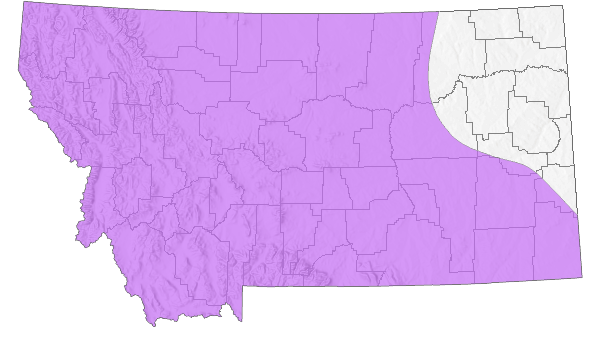
 Native
Native
Range Comments
From Alaska east across boreal Canada to Labrador, Nova Scotia and New England, in the mountain west to southern California, southeastern Arizona and southern New Mexico, east to the Black Hills of South Dakota; strays to Kansas and Nebraska (Scott 1986; Opler and Wright 1999; Glassberg 2001); at elevations above 910 m in the Pacific Northwest to 4270 m in Colorado, but usually below 3000 m (Brown 1957; Scott and Scott 1978; Ferris and Brown 1981; Pyle 2002; James and Nunnallee 2011). In Montana, reported from every county in the western two-thirds of the state (Kohler 1980; Stanford and Opler 1993). Common (Glassberg 2001).
Observations in Montana Natural Heritage Program Database
Number of Observations: 86
(Click on the following maps and charts to see full sized version)
Map Help and Descriptions
Relative Density
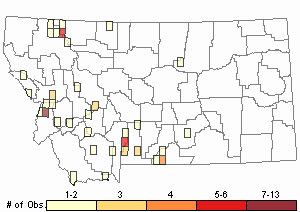
Recency
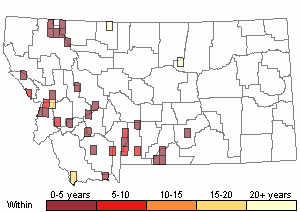
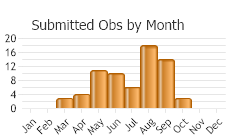
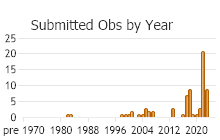
 (Observations spanning multiple months or years are excluded from time charts)
(Observations spanning multiple months or years are excluded from time charts)
Migration
Elevational migrant; appears to fly to higher elevations in summer, returning to lower elevations in autumn where it hibernates (Scott 1986; Pyle 2002; James and Nunnallee 2011).
Habitat
Taiga, montane dry and wet meadows, along streams, roads, trails, coniferous and mixed hardwood forest, riparian woodland, towns, prairie, to above treeline in alpine tundra and on summits (Emmel 1964; Scott 1986; Opler and Wright 1999; Pyle 2002; James and Nunnallee 2011). In Glacier National Park, Montana reported from mesic meadows and high elevation subalpine-alpine ecotones (Debinski 1993).
Food Habits
Larval food plants include Menziesia, Rhododendron, Ribes (several species), and Ulmus (Scott 1986; Pyle 2002; James and Nunnallee 2011); Alnus and Salix reported in British Columbia for P. g. gracilis (Guppy and Shepard 2001). Adults feed on flower nectar (including Anaphalis, Antennaria, Apocynum, Arctostaphylos, Arnica, Aster, Barbarea, Berberis, Calyptridium, Ceanothus, Centaurea, Chrusothamnus, Cirsium, Erigeron, Erioganum, Erysimum, Geranium, Jamesia, Physocarpus, Potentilla, Prunus, Ribes, Rubus, Rudbeckia, Salix, Sedum, Senecio, Solidago, Taraxacum, Thermopsis, Thlaspi, Wyethia), rotten fruit, sap, aphid honeydew, mud, and dung (Emmel 1964; Scott 2014).
Reproductive Characteristics
Females lay eggs singly or in groups of 3-4 usually on undersides of host plant leaves. Eggs hatch in 4-5 days (depending on temperature) and develop to pupation in another 25 days, each instar averaging 5 days. Larvae rest on host plant stems or leaves when not feeding, usually on the undersides; do not construct shelters or nests but feed openly. Adults emerge from pupae after about 9 days; overwinter (hibernate) as adults (Scott 1992; James and Nunnallee 2011). Males perch mostly in afternoon on bushes or shrubs, stones, logs in gullies and valley bottoms waiting for females to pass nearby (Scott 1975b, 1986).
Stewardship Responsibility
References
- Literature Cited AboveLegend:
 View Online Publication
View Online Publication Brown, F.M. 1957. Colorado Butterflies. Proceedings; Numbers Three through Seven. Denver Museum of Natural History, Denver, Co.
Brown, F.M. 1957. Colorado Butterflies. Proceedings; Numbers Three through Seven. Denver Museum of Natural History, Denver, Co. Debinski, D. 1993. Butterflies of Glacier National Park, Montana. Occasional Papers of the Museum of Natural History, the University of Kansas, Lawrence, Kansas. No. 159: 1-13.
Debinski, D. 1993. Butterflies of Glacier National Park, Montana. Occasional Papers of the Museum of Natural History, the University of Kansas, Lawrence, Kansas. No. 159: 1-13. Emmel, T.C. 1964. The ecology and distribution of butterflies in a montane community near Florissant, Colorado. American Midland Naturalist 72(2): 358-373.
Emmel, T.C. 1964. The ecology and distribution of butterflies in a montane community near Florissant, Colorado. American Midland Naturalist 72(2): 358-373. Ferris, C.D. and F.M. Brown (eds). 1981. Butterflies of the Rocky Mountains. Univ. of Oklahoma Press. Norman. 442 pp.
Ferris, C.D. and F.M. Brown (eds). 1981. Butterflies of the Rocky Mountains. Univ. of Oklahoma Press. Norman. 442 pp. Glassberg, J. 2001. Butterflies through Binoculars: A Field Guide to the Butterflies of Western North America. Oxford University Press.
Glassberg, J. 2001. Butterflies through Binoculars: A Field Guide to the Butterflies of Western North America. Oxford University Press. Guppy, C.S. and J.H. Shepard. 2001. Butterflies of British Columbia: including western Alberta, southern Yukon, the Alaska Panhandle, Washington, northern Oregon, northern Idaho, northwestern Montana. UBC Press (Vancouver, BC) and Royal British Columbia Museum (Victoria, BC). 414 pp.
Guppy, C.S. and J.H. Shepard. 2001. Butterflies of British Columbia: including western Alberta, southern Yukon, the Alaska Panhandle, Washington, northern Oregon, northern Idaho, northwestern Montana. UBC Press (Vancouver, BC) and Royal British Columbia Museum (Victoria, BC). 414 pp. James, D.G. and D. Nunnallee. 2011. Life histories of Cascadia butterflies. Corvallis, OR: Oregon State University Press. 447 p.
James, D.G. and D. Nunnallee. 2011. Life histories of Cascadia butterflies. Corvallis, OR: Oregon State University Press. 447 p. Kohler, S. 1980. Checklist of Montana Butterflies (Rhopalocera). Journal of the Lepidopterists' Society 34(1): 1-19.
Kohler, S. 1980. Checklist of Montana Butterflies (Rhopalocera). Journal of the Lepidopterists' Society 34(1): 1-19. Opler, P.A. and A.B. Wright. 1999. A field guide to western butterflies. Second edition. Peterson Field Guides. Houghton Mifflin Company, Boston, Massachusetts. 540 pp.
Opler, P.A. and A.B. Wright. 1999. A field guide to western butterflies. Second edition. Peterson Field Guides. Houghton Mifflin Company, Boston, Massachusetts. 540 pp. Pyle, R.M. 2002. The butterflies of Cascadia: a field guide to all the species of Washington, Oregon, and surrounding territories. Seattle Audubon Society, Seattle, Washington. 420 pp.
Pyle, R.M. 2002. The butterflies of Cascadia: a field guide to all the species of Washington, Oregon, and surrounding territories. Seattle Audubon Society, Seattle, Washington. 420 pp. Scott, J.A. 1975b. Mate-locating behavior of western North American butterflies. Journal of Research on the Lepidoptera 14:1-40.
Scott, J.A. 1975b. Mate-locating behavior of western North American butterflies. Journal of Research on the Lepidoptera 14:1-40. Scott, J.A. 1986. The butterflies of North America: a natural history and field guide. Stanford University Press, Stanford, California.
Scott, J.A. 1986. The butterflies of North America: a natural history and field guide. Stanford University Press, Stanford, California. Stanford, R.E. and P.A. Opler. 1993. Atlas of western USA butterflies: including adjacent parts of Canada and Mexico. Unpubl. Report. Denver and Fort Collins, Colorado 275 pp.
Stanford, R.E. and P.A. Opler. 1993. Atlas of western USA butterflies: including adjacent parts of Canada and Mexico. Unpubl. Report. Denver and Fort Collins, Colorado 275 pp.
- Additional ReferencesLegend:
 View Online Publication
View Online Publication
Do you know of a citation we're missing? Allen, T.J., J.P. Brock, and J. Glassberg. 2005. Caterpillars in the field and garden: a field guide to the butterfly caterpillars of North America. Oxford University Press.
Allen, T.J., J.P. Brock, and J. Glassberg. 2005. Caterpillars in the field and garden: a field guide to the butterfly caterpillars of North America. Oxford University Press. Brock, J.P. and K. Kaufman. 2003. Kaufman Field Guide to Butterflies of North America. Houghton Mifflin Company, New York, NY 284 pp.
Brock, J.P. and K. Kaufman. 2003. Kaufman Field Guide to Butterflies of North America. Houghton Mifflin Company, New York, NY 284 pp. Caruthers, J.C., and D. Debinski. 2006. Montane meadow butterfly species distributions in the Greater Yellowstone Ecosystem. University of Wyoming National Park Service Research Center Annual Report, 2006. Vol. 30, Art. 14. 85-96.
Caruthers, J.C., and D. Debinski. 2006. Montane meadow butterfly species distributions in the Greater Yellowstone Ecosystem. University of Wyoming National Park Service Research Center Annual Report, 2006. Vol. 30, Art. 14. 85-96. Debinski, D. M. 1991. Inventory and monitoring of biodiversity: an assessment of methods and a case study of Glacier National Park, MT. Ph.D. Dissertation. Montana State University, Bozeman. 205 p.
Debinski, D. M. 1991. Inventory and monitoring of biodiversity: an assessment of methods and a case study of Glacier National Park, MT. Ph.D. Dissertation. Montana State University, Bozeman. 205 p. Forister, M.L., C.A. Halsch, C.C. Nice, J.A. Fordyce, T.E. Dilts, J.C. Oliver, K.L. Prudic, A.M. Shapiro, J.K. Wilson, J. Glassberg. 2021. Fewer butterflies seen by community scientists across the warming and drying landscapes of the American West. Science 371:1042-1045.
Forister, M.L., C.A. Halsch, C.C. Nice, J.A. Fordyce, T.E. Dilts, J.C. Oliver, K.L. Prudic, A.M. Shapiro, J.K. Wilson, J. Glassberg. 2021. Fewer butterflies seen by community scientists across the warming and drying landscapes of the American West. Science 371:1042-1045. Forister, M.L., E.M. Grames, C.A. Halsch, K.J. Burls, C.F. Carroll, K.L. Bell, J.P. Jahner, et al. 2023. Assessing risk for butterflies in the context of climate change, demographic uncertainty, and heterogeneous data sources. Ecological Monographs 93(3):e1584. https://doi.org/10.1002/ecm.1584
Forister, M.L., E.M. Grames, C.A. Halsch, K.J. Burls, C.F. Carroll, K.L. Bell, J.P. Jahner, et al. 2023. Assessing risk for butterflies in the context of climate change, demographic uncertainty, and heterogeneous data sources. Ecological Monographs 93(3):e1584. https://doi.org/10.1002/ecm.1584 Fultz, J.E. 2005. Effects of shelterwood management on flower-visiting insects and their floral resources. M.Sc. Thesis. Bozeman, MT: Montana State University. 163 p.
Fultz, J.E. 2005. Effects of shelterwood management on flower-visiting insects and their floral resources. M.Sc. Thesis. Bozeman, MT: Montana State University. 163 p. Sater, S. 2022. The insects of Sevenmile Creek, a pictorial guide to their diversity and ecology. Undergraduate Thesis. Helena, MT: Carroll College. 242 p.
Sater, S. 2022. The insects of Sevenmile Creek, a pictorial guide to their diversity and ecology. Undergraduate Thesis. Helena, MT: Carroll College. 242 p.
- Web Search Engines for Articles on "Hoary Comma"
- Additional Sources of Information Related to "Insects"





